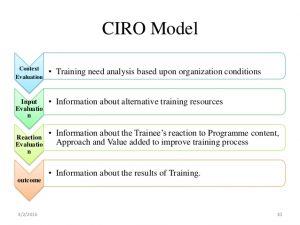CIRO Model
The CIRO Model stands for context, input, reaction and output. This model is different from the Kirkpatrick’s models. The main difference between them both is the CIRO focuses on the measurements taken before and after the training has been carried out. Some practitioners feel that this model this model is best suited to the training management programme. As it doesn’t account behaviour rather it’s not for the people working at the lower levels of the organization.
- Context: this is all about identifying and evaluating the training needs. The needs-based on collecting performance deficiencies information. Training objectives can be set at the follo0wing three levels:
The ultimate objective: this eliminates the particular organizational deficiencies.
The intermediate objectives: to achieve the ultimate objective then changes in employees’ work behaviour is necessary.
The immediate objectives: this is all about achieving the immediate objectives by acquiring the skills, new knowledge, or attitude employees’ can change their behaviour
- Input: In terms of design, planning, management and delivery this analysis the effectiveness of the training courses. Also, analysis of organizational resources available is involved and determines how this can be best used to achieve the desired objectives.
- Reaction: in order to make improvements this helps in analyzing the reactions of the delegates. The evaluation is subjective, so, there is a need for it to be collected in an objective and subjective way as possible.
- Outcome: the evaluation of outcomes is done in terms of what actually happened as a training result. The outcomes are measured on the following four levels depending on the available resources and the purpose of evaluation.
The learner level, The workplace level, The team or department level, The business level
For certification in the L&D visit –

